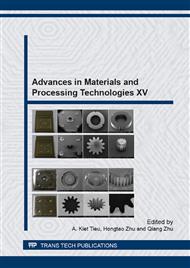p.370
p.377
p.392
p.400
p.409
p.414
p.420
p.429
p.437
Tool Wear and Surface Roughness when Machining AlSi/AlN Metal Matrix Composite Using Uncoated Carbide Cutting Tool
Abstract:
Aluminium silicon alloy (AlSic) matrix composite reinforced with aluminium nitride (AlN) particle is a new generation material for automotive and aerospace application. This material has low density, light weight, high strength, high hardness and stiffness. Metal Matrix Composit (MMC) material is one of the advanced materials which have good future prospects. This paper presents the study of tool wear and surface roughness investigation when milling AlSi/AlN Metal Matrix Composite using uncoated carbide cutting tool. The volume of AlN reinforced particle was 10%. The milling process was carried out under dry cutting condition. The uncoated carbide insert parameters used were cutting speed of (250-750 m/min), while feed rate and depth of cut were kept constant at 0.15 mm/tooth of 0.3mm respectively. The Sometech SV-35 video microscope system and Mitutoyo surface roughness tester were used for tool wear measurements and surface roughness respectively. The results revealed that the tool wear increases with cutting speed (450 m/min). While at high cutting speed, the surface finish improves. It was found that the cutting speed of 750m/min was optimum condition for obtaining smooth finish and longer tool life. Keywords: AlSi/AlN Metal Matrix Composite milling process, tool wear, and surface roughness, uncoated cemented carbide tool
Info:
Periodical:
Pages:
409-413
Citation:
Online since:
November 2013
Price:
Сopyright:
© 2014 Trans Tech Publications Ltd. All Rights Reserved
Share:
Citation:


